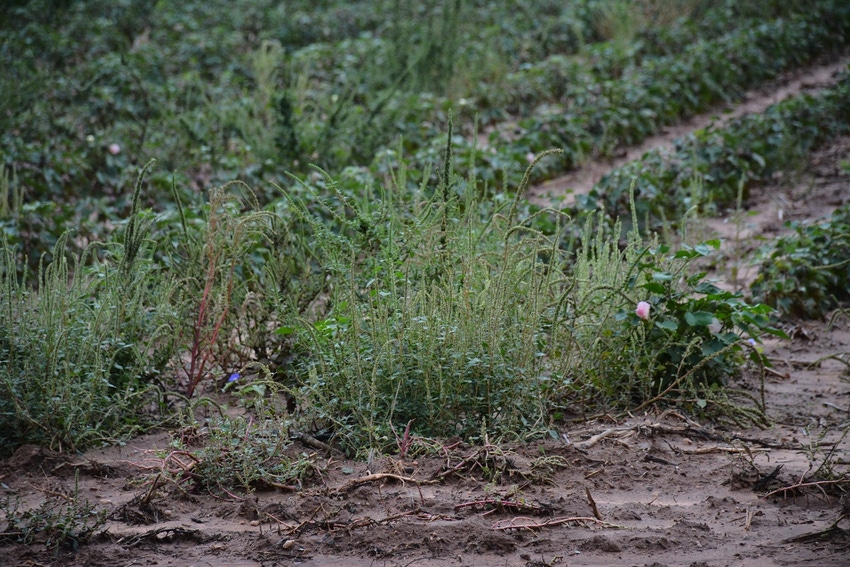
The old saw, "Those who do not learn history are doomed to repeat it," attributed to George Santayana, should be made into a bumper sticker and slapped onto the side of every spray rig in the cotton belt as a constant reminder that overuse of new chemistry will shorten its useful life.
Overuse of Roundup Ready technology resulted in what Todd Baughman, Oklahoma State University Extension agronomist, refers to as Public enemy No. 1: herbicide-resistant pigweed.
Speaking via Skype to those attending the Red River Crops Conference at Childress, Texas, he said the trouble glyphosate-resistant weeds have caused farmers should be reason enough to adopt a complete weed management program for cotton and other crops on which producers are using new herbicide-tolerant technology.
“Remember when we could control large pigweed plants with Roundup?” he says. “No longer. That’s why we promote use of residual herbicides in combination with new technologies to help limit development of resistance to dicamba and 2, 4-D. We want to keep those products around as long as possible.”
Pigweed (Palmer amaranth) has been a troublesome weed in Southwest crops for some time, Baughman notes. “We’ve dealt with it for a long time — and we know that some of the old technology still works.”
Old school products, he says, will be useful in managing pigweed and other weed species in conjunction with new technologies — XtendFlex and Enlist. “These are exciting, but we need to use the same principles we depended on before Roundup Ready crops were available. Otherwise, we risk losing the technology.”
A LEARNING CURVE
The new dicamba and 2, 4-D formulations, which include technology to limit volatility and off-target drift, will be available for use on cotton this year — but they will come with a learning curve.
Xtendimax, a dicamba product from Monsanto, is labeled for use on XtendFlex cotton varieties. Engenia, from BASF, is also labeled for XtendFlex cotton. Baughman says DuPont may have a product similar to Xtendimax later this year. Enlist Duo, a Dow 2, 4-D product, is labeled for Enlist cotton varieties tolerant to 2, 4-D and glyphosate.
These products and varieties are not interchangeable. Enlist cotton will not tolerate dicamba, and XtendFlex cotton will not tolerate 2, 4-D.
Baughman says Xtendimax is not labeled for tank mixes yet, and is labeled for use with only 1 spray nozzle. Check websites for both Xtendimax (xtendimaxapplicationrequirements.com) and Engenia (engeniatankmix.com) for future additional tank mixes and nozzles. Enlist restrictions include selected nozzles and tank mix with only approved products (see http://www.enlist.com/en/tank-mix).
Neither the dicamba nor the 2, 4-D products may be applied aerially, and they must be applied with a minimum of 10 gallons of water per acre.
Xtendimax and Enlist Duo restrictions include maximum sprayer speed of 15 miles per hour; maximum boom height of 24 inches above target; do not apply in wind less than 3 miles per hour or more than 15 miles per hour; do not apply toward sensitive crops when wind is blowing more than 10 miles per hour. For Xtendimax, do not tank mix with AMS or UAN.
RESTRICTIONS/BUFFERS
Both systems have specific restrictions, including buffer zones, to protect sensitive plants and sensitive areas, such as apiaries. The restrictions and buffers are necessary, says Baughman, because “the No. 1 issue is drift. The lower volatility is good, but it’s not bulletproof. Do not spray in a high wind. We’ve seen drift issues before with Roundup and other products with no real volatility issues. Care is essential.”
He says spray applicators should pay close attention to labels, especially application issues, pressure, and nozzles. “Sprayer contamination could be a big issue, especially when the equipment is moved from a tolerant to a non-tolerant crop. Proper cleanout is critical. Also, do not let product stay in the sprayer overnight — then it’s almost impossible to clean it out of the sprayer tank.”
Weed target and weed size are important concerns. “Yield competition is an issue with larger weeds, and harvest issues are also possible without adequate control. And resistance continues to be a concern.”
Baughman says developing a weed management system will help preserve the new technologies. Preemerge herbicide products, residual herbicides applied up front, he says, should be a part of a program that also takes advantage of the new technology.
Product stewardship may be more critical than ever. “I don’t know what the next herbicide will be,” he says. “We’ve not had a new mode of action for the last 10 to 20 years.”
He cautions Oklahoma and some Rolling Plains Texas farmers to be aware of existing restrictions on dicamba and 2, 4-D use. Those limitations are still in effect in some cases, and applicators will have to apply for the appropriate permits to be able to use the products. “It’s important that we use these products in the most efficient and legal way,” Baughman says.
New technology for grain sorghum, ALS herbicide-resistant hybrids, can add a new wrinkle to weed control, and offer some rotation advantages, he says. The hybrid technology, Inzen, was developed at Kansas State, using traditional breeding methods. One herbicide, Zest, is currently labeled for use on these hybrids. “It’s something to look at,” Baughman says.
About the Author(s)
You May Also Like






